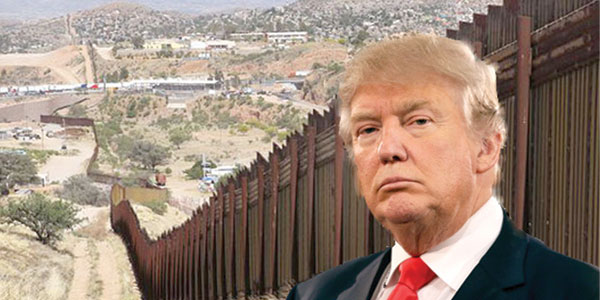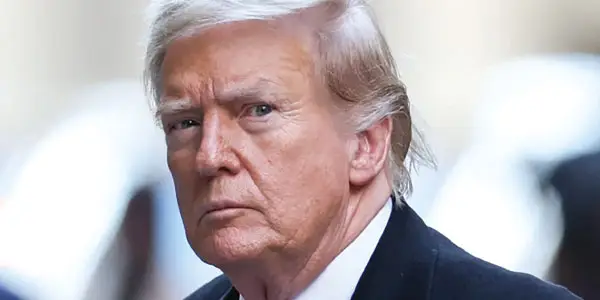
President Donald Trump has already built a wall, but it’s inside his head. No matter how many times he is told that a physical barrier between Mexico and the United States won’t considerably deter the smuggling of drugs or undocumented people into this country, he keeps insisting that it be built. It’s an absurd and outdated idea.
Building walls to protect borders, is, of course, an ancient concept. Tall, powerful walls kept foes from storming the castles of Europe during the Middle Ages; and from the 14th through the 17th centuries, China’s Great Wall helped keep the Ming dynasty safe from the nomadic tribes of Asia. But in a 21st century marked by globalization, technological shifts and the rapid movement of people, walls just make no sense as border deterrents.
Still, Trump wants his.
His insistence began on the day he announced he was running for president in 2015. “I will build a great wall, and nobody builds walls better than me, believe me,” Trump said then. “And I’ll build them very inexpensively … and I will make Mexico pay for that wall. Mark my words.”
I have indeed marked his words, and say once again that Trump is lying. Trump will not build a great wall on the border with Mexico, nor will he build an inexpensive one, and Mexico will certainly not be paying for it. Yet the president refuses to tell the truth; his campaign pledge only stoked prejudice and insults to win votes.
John Kelly, Trump’s chief of staff, who recently acknowledged to a group of lawmakers that Trump wasn’t “fully informed” during his campaign about what building a wall with Mexico would involve, is also aware of this. When the president’s main adviser says his boss doesn’t know what he’s talking about, we know something very serious is going on.
The main problem is that a wall would prevent neither people nor drugs from entering the United States. Many immigrants arrive here with a visa, by airplane, and illicit drugs are smuggled in through tunnels and airports. Nevertheless, Trump wants his wall.
It’s very difficult to understand why a man who describes himself as a genius — and a great entrepreneur — would ask Congress for $18 billion to build a project that will not work. According to reports from The Wall Street Journal, the money would be used to add about 350 miles of fencing to an existing 654-mile border wall; even if the project were completed, about 1,000 miles along the border would still have no physical barrier.
It’s worth noting that we’ve had a similar debate before. Former President Bill Clinton put Operation Gatekeeper in place in 1994 with the purpose of restricting the passage of undocumented immigrants to San Diego from Tijuana. The program increased the number of border patrol agents in the area and built miles of new fence (yes, Democrats have also voted to build a wall along the Mexican border).
In the end, Operation Gatekeeper failed. Undocumented immigrants stopped entering San Diego through Tijuana, but they started crossing deserts and mountain ranges and passing through other states. The crossing became an extremely dangerous undertaking. Over the years, thousands died attempting it.
Operation Gatekeeper was like placing a big stone in a moving river; the water just ran around the sides. Neither more walls nor more agents prevented the growth in the undocumented immigrant population, from 3.5 million in 1990 to 11.2 million by 2013, according to data from the American Immigration Council.
Conclusion: No wall can stop an undocumented immigrant if they are determined to cross over, much less if they are hungry and have been promised a job up north. And no wall can stop the flow of drugs from Latin America into the U.S. as long as there are millions of drug addicts living here. Migration and drug trafficking are, in the end, a matter of supply and demand.
I do believe that every country has a right to secure its borders. But there are much more humane and rational ways to protect a country than building walls. The renegotiation of NAFTA could do more to regulate the entrance of undocumented people into the U.S. than a 350-mile wall ever could.
Sadly, the hardest walls to bring down are the ones we erect in our heads.
________________________________________________________________________________________________
Un Muro Inútil
El presidente Donald Trump tiene un muro en la cabeza. Por más que le dicen que una muralla entre México y Estados Unidos no va a detener significativamente el paso de drogas e indocumentados, él insiste en la absurda y anticuada idea.
El muro es un concepto muy viejo. Altos y poderosos muros tenían el propósito de mantener a los enemigos fuera de los castillos en la Europa medieval y, del siglo XIV al XVII, la principal ampliación de una gran muralla en China le sirvió a la dinastía Ming para protegerse de grupos nómadas. Sin embargo, en un siglo XXI marcado por la globalización, la tecnología y el movimiento de gente, los muros no tienen sentido.
Pero Trump quiere el suyo.
Su insistencia comenzó en 2015 el día que lanzó su candidatura presidencial. “Voy a construir un gran muro y nadie construye mejores muros que yo, créanme”, dijo Trump en ese entonces. “Los construiré a muy bajo costo, y voy a hacer que México pague por ese muro. Apunten mis palabras”.
Yo las apunté, y por eso digo que Trump, una vez más, está mintiendo. Trump no construirá un gran muro en la frontera con México, ni lo podrá hacer a muy bajo costo, ni México pagará por él. El Presidente se rehúsa a decirle la verdad a los estadounidenses: Que su promesa de campaña fue sólo un manojo de prejuicios e insultos para ganar votos.
Eso lo sabe también John Kelly, su jefe de gabinete, quien recientemente reconoció ante un grupo de legisladores que Trump no estaba “suficientemente informado” durante la campaña sobre los problemas para construir un muro con México. Es grave cuando el principal asesor del presidente asegura que su jefe no sabe lo que dice.
El problema es que sería un muro inútil. No detendría a la mayoría de los inmigrantes y las drogas que entran al país. ¿Por qué? Porque muchos inmigrantes llegan con visa y por avión, y las drogas entran por túneles y aeropuertos. Por eso.
Y a pesar de todo, Trump quiere su muro.
Es difícil de entender por qué un hombre que se describe como “genio” y como un gran empresario le ha pedido al Congreso $18 mil millones de dólares para un proyecto que no va a funcionar. El dinero se usaría, según reportó The Wall Street Journal, para añadir unas 350 millas de muro a las 654 que ya lo tienen. Aún así, quedarían otras mil millas sin ningún tipo de barrera física entre México y Estados Unidos.
Este mismo debate ya lo hemos tenido antes. El expresidente Bill Clinton ordenó la llamada Operación Gatekeeper en 1994 con el propósito de limitar el paso de indocumentados de Tijuana a la zona de San Diego. Aumentó el número de agentes en ese paso fronterizo y construyó varias millas de muro (sí, los demócratas también han votado por poner un muro en la frontera con México).
¿Y cuál fue el resultado de la Operación Gatekeeper? Un tremendo fracaso. Los inmigrantes indocumentados dejaron de cruzar de Tijuana a San Diego, pero se fueron a los desiertos, zonas montañosas y a otros estados para hacerlo. Cruzar se convirtió en una aventura sumamente peligrosa. Miles han muerto en el intento.
La Operación Gatekeeper fue como poner una gran piedra en un río: El agua se va por los lados. Más muros y más agentes no pudieron evitar que la población indocumentada pasara de 3,5 millones en 1990 a 11,2 millones en el 2013, según el American Immigration Council.
Conclusión: Ningún muro puede parar a un indocumentado decidido a cruzar, menos si tiene hambre y existe la promesa de un trabajo en el norte. Además, mientras haya millones de consumidores de drogas en Estados Unidos, habrá narcotraficantes que las traigan. La migración y el narcotráfico son, al final de cuentas, una simple cuestión de oferta y demanda.
Creo que todos los países del mundo tienen el derecho a fronteras seguras, pero hay formas mucho más humanas y racionales de proteger a un país que tratar de acomodar un pedazo de la Gran Muralla China en la frontera entre México y Estados Unidos. Un acuerdo migratorio entre México, Estados Unidos y Canadá, paralelo al Tratado de Libre Comercio, que se está negociando en este momento, haría mucho más por regular la entrada de indocumentados que las 350 millas de muro que quiere construir Trump.
Los muros más difíciles de tumbar son los que tenemos en la cabeza.









